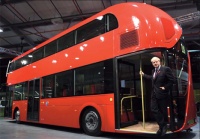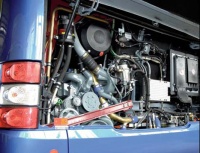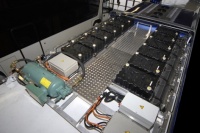
Tradition and technology are being brought together in London as the city’s iconic red buses receive a green makeover. But the type of systems that will drive this change are yet to be determined and the options are causing division among the UK’s engineering community.
Earlier this month, mayor Boris Johnson unveiled a life-size mock-up of the famous open-backed Routemaster bus at the London Transport Museum. The bus is expected to be on London’s streets during the Olympics as part of a wider plan to roll out 300 hybrid buses in London by 2012. At the moment, almost all of Transport for London’s (TFL’s) buses are powered by diesel engines, with the exception of 56 buses that use hybrid propulsion systems.
The hybrid fleet was a trial launched in 2006 when a number of manufacturers were brought in to test the suitability of different hybrid drivetrains in the urban environment. The options were split into two categories: a parallel hybrid, where the bus is driven by the battery or directly by the engine, or a series hybrid system, where there is no direct link between the engine and wheels, with the bus driven solely by battery power.
Wrightbus and ADL went for the series-hybrid drivetrain with a lithium-ion battery pack, while Volvo and Optare chose the parallel hybrid, with the latter opting for a nickel-metal hydride battery over lithium ion. Series hybrids are recognised as being more suitable for start-stop applications.
’In 95 per cent of drive cycles, a series system is more efficient,’ said Brian Maybin, Wrightbus engineering director. ’For urban transportation, where distances between bus stops are around 50-500m, there is a robust case for using a series hybrid.’

The series hybrid offers more options in terms of layout, so the engine can be packaged in new locations
The series hybrid also offers more options for the layout of the bus. While in a parallel system the mechanical drive shaft has to be 1.5-2m away from the rear axle, in a series there is no mechanical link between the engine and the rear axle. This means that the engine can be packaged in new locations to suit the layout of the passenger compartment. ’There are lots of things you can do that may appear daft’ said Maybin. ’For instance, you could place the engine in the upper deck of a double-decker bus, or you could hide it below a staircase. There aren’t really any constraints.’
The amount of noise, vibration and harshness generated by the vehicle is also reduced in a series-hybrid drivetrain. Running at a steady state speed using a smaller engine, the system has a smoother acceleration from standstill to maximum speed with no need to hand over from an electric motor to a mechanical engine. Meanwhile, a parallel system usually pushes off using electrical motor power, with the engine kicking in when speed picks up, causing a noticeable jolt during transition.
But Volvo’s engineers aren’t convinced by the benefits of series hybrids. ’We used to have series hybrids in our fleet, but they are very sensitive to failure,’ said Volvo Bus environmental director, Edward Jobson. ’If any of the electrical components fail it comes to a complete standstill and many of the new components are susceptible to this.’

“Hybrid technology will be the bridge to zero emissions, but it has some way to go”
EBERHARD HIPP, MAN
Maybin agrees and stated that technology development, particularly on series-hybrid drivetrains, will benefit projects focusing on fully electric and fuel-cell vehicles of the future. ’All vehicles will tend towards electric propulsion and that means that they will tend towards series hybrid architecture. I think, in the short term, there is still an application for normal diesel drivelines. They are being improved and they will still have some life over the next five to 10 years. In that period, the price, robustness and reliability of hybrid vehicles will become optimised and we will see a massive transition from conventional diesel buses to hybrid-electric diesel buses.’
Loughborough and Brunel universities’ work on air-hybrid powertrains and the Flybus project are among other UK initiatives that could change the direction of hybrid buses in the future. TFL claims that it is not backing any horses and will wait to see the results of further research. What is certain is that hybrid technology will increasingly be driven in our city centres, but exactly which system will become the frontrunner remains to be seen.
flybus project in depth
The CVT/flywheel system offers an alternative to battery-based enginesThe Flybus project began last year with the aim of demonstrating a viable alternative to battery-based hybrid buses. Earlier this month, construction of the first prototype vehicle began, which - according to project leaders - could deliver up to 20 per cent savings in energy consumption.
The project is headed by transmission company Torotrak, with contributions from Ricardo, Optare and Allison Transmissions. Research is based around Torotrak’s Continuously Variable Transmission (CVT) technology, together with a high-speed composite flywheel for an energy-storage system known as ’Kinergy’.
The team has used the high-speed flywheel, which recycles the kinetic energy that would otherwise be wasted in the brakes. As the bus slows, instead of converting its kinetic energy into heat in the brakes, the CVT transfers energy to the flywheel, spinning it up to speeds of around 60,000rpm.
When the vehicle pulls away from rest, the CVT returns energy from the flywheel to the bus, meaning there is less work for the engine to do and reducing fuel consumption. In the process, the flywheel gives up energy and slows down until re-energised during the next vehicle deceleration.
According to Torotrak’s engineering director, Roger Stone, the technology offers easier installation than battery-electric systems. It also provides comparable gains in fuel economy in a package that is half the size, half the weight and a quarter of the cost.










Guest blog: exploring opportunities for hydrogen combustion engines
"We wouldn't need to pillage the environment for the rare metals for batteries, magnets, or catalisers". Batteries don't use rare...